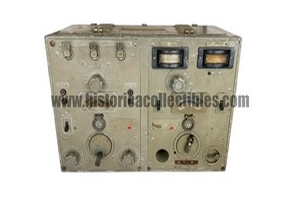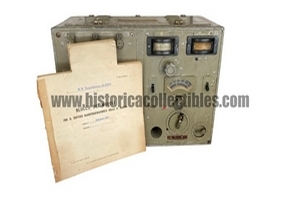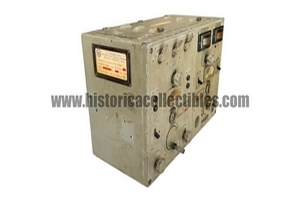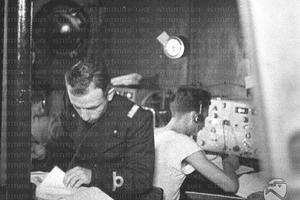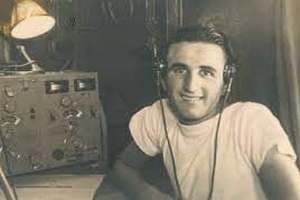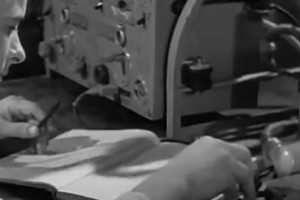Radio Transceiver R.M.5 Allocchio Bacchini, Royal Italian Torpedo Boat Aliseo, circa 1943
Radio Rice-Transmitter R.M.5, produced by Allocchio Bacchini in 1943 for the Royal Italian Navy, and installed on the legendary Royal Italian Torpedo Boat Ship Aliseo with which the Commander Naval Ace Carlo Fecia di Cossato carried out important missions which contributed to making it one of the Most important officers of the Royal Italian Navy and of the history of Italy.
It should be considered that, in all likelihood, 2 important and significant orders were transmitted from this radio:
«If the delivery order is confirmed, wherever you are, launch all your torpedoes and fire all the shots you have on board at the ships around you, to remind the Anglo-Americans that the commitments must be respected; If you're still afloat in the end, scuttle yourself."
In fact, the ship, based in Taranto, also operated during the co-belligerence on escort missions, remaining in command of Fecia di Cossato and, when in the spring of 1943 the news spread that, despite the co-belligerence, the Italian ships would still be handed over to the victorious powers, Fecia di Cossato issued the order not to accept the delivery.
Following this, in June 1944, when the new government presided over by Ivano and Bonomi, took office refusing to swear loyalty to the King, the high command of the Navy adapted to the ministerial choice but, on 22 June, Carlo Fecia di Cossato, of faced with the request of Admiral Nomis di Pollone to recognize the new Government of the South with an oath of loyalty and go out on patrol, he refused, saying that he did not recognize as legitimate a government that had not sworn an oath to the King and which therefore would not have carried out the orders that came from that government:
«No, Mr. Admiral, our duty is different. I do not recognize as legitimate a government that has not sworn an oath to the King. Therefore I will not follow the orders that come to me from this government. The order is to go out to sea tomorrow morning in command of the torpedo boat "Aliseo". Well the "Aliseo" will not come out.»
This radio accompanied the war life of the Aliseo torpedo boat since February 1943 as there is a document, housed in a special collection frame, issued by the "Technical, Assignment and Testing Office" of the S.A. NAVALMECCANICA - Neapolitan Naval and Mechanical Establishments (Establishment responsible for the construction of the Ship), in which important information fundamental to the identification of the Aliseo torpedo boat is collected. Furthermore, the radio is accompanied by the "Block of Radiotelegraph Transmission Modules" with the name of the R.N. Torpedo Boat Aliseo written in the header.
The radio consists of a Transmitter for continuously variable transmission from 1360 to 3330 Khz (RT emission of modulated waves and radio with a power of 40 Watts) and a Receiver with continuously variable reception from 1360 to 3330 Khz. The total weight of the 2 modules is approximately 11 kg.
The Royal Italian Torpedo Boat "ALISEO" was a modern unit of the Ciclone class, specifically designed for the escort of convoys along the treacherous routes to North Africa. The torpedo boat entered service at the end of February 1943, during the final phase of the convoy war for Tunisia. The Aliseo was among other things the first torpedo boat to be equipped with a German-made radar, the «Fu.Mo. 31/42". The first Commander of the ship was, from February to April 1943, Lieutenant Commander Umberto Manacorda, replaced on 17 April 1943 by Frigate Captain Carlo Fecia di Cossato, former ace of the Atlantic Submarines.
On 22 July 1943 the Aliseo left Pozzuoli to escort the steamers Adernò and Colleville to Civitavecchia, together with the German torpedo boat TA 11 and two submarine chasers. On the morning of 23 July the convoy was attacked by planes: one of the enemy aircraft was shot down and one of the Italian-German escort was damaged and forced to ditch, while the Aliseo had damage to the main deck, a serious fire near the bombs of depth and at the rudder due to the strafing. Fecia di Cossato decided to continue the convoy while his ship towed the ditched plane to the shore and repaired the damage to the rudder; the trade wind rejoined the other ships at 5.30pm. Around 7.30 pm, however, the Adernò was torpedoed by the British submarine Torbay and sank within a few minutes: the Aliseo, after having lowered a motor launch to fish out the shipwrecked people, carried out a fruitless anti-submarine hunt for several hours.
On the day of the proclamation of the armistice, the Aliseo was in the La Spezia base: during the day of 8 September the unit and a sister ship, the Ardito, set sail from the Ligurian port. The commander of the torpedo boats, Admiral Amedeo Nomis of Pollone, and Admiral Aimone of Savoia-Aosta had also embarked on the trade wind. The two units headed to Bastia, where they arrived in the evening upon learning of the Armistice Proclamation. On 9 September, while the German troops proceeded to occupy the Corsican port, the ship managed to leave, while the Ardito remained stuck inside the port and was heavily damaged by the fire of the coastal batteries, which fell into the hands of the Wehrmacht, and of numerous German units. Fecia di Cossato, seeing the other torpedo boat in difficulty, reversed course and faced eleven German boats: the submarine chasers UJ 2203 and UJ 2219, escorting the armed motorboats F 366, F 387, F 459, F 612 and F 623, the Luftwaffe motorboat FL B. 412 and the armed steamers Humanitas and Sassari, Italian but captured by the Germans. The ship was also supported in the action by some batteries that had been reconquered by the Italian artillerymen and by the intervention, in the final phase of the combat, of the corvette Cormorano.
The Aliseo managed to sink both the submarine chasers and the motorboats, also putting the Humanitas and the Sassari out of action. More precisely, the Trade Wind, having received the order from the port commander, after it had been largely reconquered, to attack and destroy the German flotilla, opened fire at 7.06am from around 8300 metres, in response to the German ships, which , UJ 2203 in the lead, had already started shooting. At 7.30 am the Aliseo was hit by an 88 mm projectile in the engine room, remaining temporarily immobilised, then, having repaired the damage, it directed fire at the UJ 2203, which, devastated, blew up at 8.20 am; ten minutes later the UJ 2219 had a similar fate and therefore three of the motorboats were sunk, while the remaining two motorrafts were sent aground and the Luftwaffe boat was sunk with the help of the Cormorano, which had arrived in the meantime. The victory achieved in Bastia was among the reasons for the awarding of the Gold Medal for military valor to Fecia di Cossato.
After the battle, the Aliseo, having recovered 25 German shipwrecked men, headed together with the battered Ardito for Portoferraio (where numerous torpedo boats, corvettes and minor and auxiliary units from the Tyrrhenian ports had converged), where it arrived at 5.58pm on 9 September, disembarking the admirals Nomis of Pollone and Savoia-Aosta and the German castaways. On the morning of 11 September the ship left Portoferraio together with six other torpedo boats (including the sister ships Indomito, Animoso, Arggiatoso and Fortunale) and headed for Palermo, a port controlled by the Allies, where the group arrived at ten in the morning of 12 September. The ships remained in the harbor from 12 to 18 September, the day they entered the port and received water and supplies from the Americans. On 20 September 1943 the ship left the Sicilian port together with various other units and went to Malta, where she delivered part of the food received to the other Italian ships already arrived on the island. On 5 October the Aliseo, her twins and three other torpedo boats left Malta and returned to Italy.
The ship, based in Taranto, also operated during the co-belligerence (1943-1945) on escort missions, remaining in command of Fecia di Cossato until June 1944, when the officer was first disembarked and placed under arrest (following the refusal to take the oath to the new Bonomi government) and then, freed following riots that broke out on board the Aliseo, he was put on leave (during which he committed suicide to denounce the serious crisis of the values in which he had always believed).
Commanders
Lieutenant Commander Umberto Manacorda (born in Rome on 26 October 1913) (February - 16 April 1943)
Frigate Captain Carlo Fecia di Cossato (born in Rome on 25 September 1908) (17 April - September 1943)

